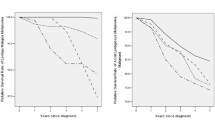Summary
The aim of this study was to characterize clinical, histological, and outcome features of primary melanoma in 1329 patients managed at a single-center institution between 2000 and 2010. Parameters included age at diagnosis, sex, tumor location, histology, stage, Breslow thickness, and sentinel lymph node status among others. The mean age at diagnosis was 59.1 ± 16.7 years. Women were significantly younger than men when diagnosed (57.2 vs. 61.0 years; p < 0.001). Most melanomas (83%) were diagnosed on typically sun-exposed skin areas. Superficial spreading melanoma (39.5%) was the most frequent histological subtype. The median Breslow thickness was significantly higher for men compared to women (1.10 mm vs. 0.90 mm; p = 0.018). 38.3% of patients with positive and 12.9% of patients with negative sentinel biopsies progressed. Five-year survival analysis for a sub-cohort of 577 patients showed better 5‑year overall survival for woman compared to men (75.8% vs. 63.6%; p = 0.025). Our findings indicate differences in patient characteristics between men and women, and underscore the importance of early melanoma detection to prevent disease progression.
Zusammenfassung
Vorgestellt wird eine deskriptive Analyse klinischer und histologischer Daten von 1329 Patienten mit primärem Melanom, die im Zeitraum 2000–2010 in der Melanomdatenbank der dermatologischen Abteilung der Krankenanstalt Rudolfstiftung erfasst wurden. Unter anderem wurden folgende Parameter analysiert: Alter bei Diagnosestellung, Geschlecht, Tumorlokalisation, histologischer Tumortyp, Tumorstadium, Breslow-Dicke und Sentinellymphknotenstatus. Das mittlere Alter bei Diagnose betrug 59,1 ± 16,7 Jahre und war bei Frauen signifikant niedriger als bei Männern (57,2 vs. 61,0 Jahre; p < 0,001). Von den Melanomen waren 83 % auf potenziell sonnenexponierter Haut lokalisiert. Am häufigsten (39,5 %) wurde der histologische Subtyp „oberflächlich spreitend“ diagnostiziert. Die mediane Breslow-Dicke war bei Männern signifikant höher als bei Frauen (1,10 vs. 0,90 mm; p = 0,018). Bei 12,9 % der Patienten mit negativem Resultat der Sentinellymphknotenbiopsie und bei 38,3 % mit positivem Resultat kam es zu einem progressiven Krankheitsverlauf. Eine Stichprobe von 577 Patienten zeigte ein signifikant höheres 5‑Jahres-Überleben für Frauen im Vergleich zu Männern (75,8 vs. 63,6 %; p = 0,025). Diese Ergebnisse bestätigen die unterschiedliche Patientencharakteristik der Melanomerkrankung im Geschlechtsvergleich und unterstreichen, wie wichtig die Früherkennung für den weiteren Krankheitsverlauf von Melanompatienten ist.



Similar content being viewed by others
References
Leitlinienprogramm Onkologie Deutsche Krebsgesellschaft, Deutsche Krebshilfe, AWMF. Diagnostik, Therapie und Nachsorge des Melanoms, Langversion 2.0, 2016, AWMF Registernummer: 032/024OL. 2016. http://leitlinienprogramm-onkologie.de/Melanom.65.0.html. Accessed 12 July 2018.
Kittler H, Binder M, Wolff K, et al. A ten-year analysis of demographic trends for cutaneous melanoma: analysis of 2501 cases treated at the University Department of Dermatology in Vienna (1990–1999). Wien Klin Wochenschr. 2001;113(9):321–7.
Rieger E, Soyer HP, Kofler R, et al. Clinical epidemiologic data of malignant melanoma based on 1,368 patients of the Graz University Dermatology Clinic (1970–1989). Wien Klin Wochenschr. 1991;103(20):612–6.
Garbe C, Orfanos CE. Epidemiology of malignant melanoma in central Europe: risk factors and prognostic predictors. Results of the Central Malignant Melanoma Registry of the German Dermatological Society. Pigment Cell Res. 1992;(Suppl 2):285–94. PMID: 1409431
Binder M, Pehamberger H, Steiner A. Das maligne Melanom in Österreich: Analyse des Patientenkollektivs der I. Universitäts-Hautklinik Wien. 1963–1988. In: Das maligne Melanom der Haut. Munich: W. Zuckschwert; 1990. pp. 25–31.
Statistik Austria. Bevölkerung im Jahresurchschnitt. Statistik Austria; Available from: http://www.statistik.at/web_de/statistiken/bevoelkerung/bevoelkerungsstand_und_veraenderung/bevoelkerung_im_jahresdurchschnitt/index.html (cited 12 Jul 2018)
Monshi B, Vujic M, Kivaranovic D, et al. The burden of malignant melanoma—Lessons to be learned from Austria. Eur J Cancer. 2016;56:45–53.
MacKie R, Aitchison T, Hunter JA, et al. Cutaneous malignant melanoma, Scotland, 1979–89. Lancet. 1992;339(8799):971–5.
Hegde UP, Grant-Kels JM. Metastatic melanoma in the older patient: special considerations. Clin Dermatol. 2013;31(3):311–6.
Tatalovich Z, Wilson JP, Mack T, et al. The objective assessment of lifetime cumulative ultraviolet exposure for determining melanoma risk. J Photochem Photobiol B. 2006;85(3):198–204.
Balch CM, Gershenwald JE, Soong S‑J, et al. Final version of 2009 AJCC melanoma staging and classification. J Clin Oncol. 2009;27(36):6199–206.
Zogakis TG, Essner R, Wang H, et al. Melanoma recurrence patterns after negative sentinel lymphadenectomy. Arch Surg. 2005;140(9):865–71. discussion 871–872.
O’Connell EP, O’Leary DP, Fogarty K, et al. Predictors and patterns of melanoma recurrence following a negative sentinel lymph node biopsy. Melanoma Res. 2016;26(1):66–70.
Biver-Dalle C, Puzenat E, Puyraveau M, et al. Sentinel lymph node biopsy in melanoma: our 8‑year clinical experience in a single French institute (2002–2009). BMC Dermatol. 2012;12:21.
Brady MS, Oliveria SA, Christos PJ, et al. Patterns of detection in patients with cutaneous melanoma. Cancer. 2000;89(2):342–7.
Giacomoni PU, Mammone T, Teri M. Gender-linked differences in human skin. J Dermatol Sci. 2009;55(3):144–9.
Author information
Authors and Affiliations
Corresponding author
Ethics declarations
Conflict of interest
V. Feichtenschlager, F. Weihsengruber, L. Richter, I. Vujic, K. Rappersberger, and C. Posch declare that they have no competing interests.
Ethical standards
All procedures performed in studies involving human participants were in accordance with the ethical standards of the institutional and/or national research committee and with the 1975 Helsinki declaration and its later amendments or comparable ethical standards. Informed consent was obtained from all individual participants included in the study.
Rights and permissions
About this article
Cite this article
Feichtenschlager, V., Weihsengruber, F., Richter, L. et al. Clinical melanoma characteristics and survival—a single-center retrospective study between 2000 and 2010. Wien Med Wochenschr 169, 323–330 (2019). https://doi.org/10.1007/s10354-018-0678-3
Received:
Accepted:
Published:
Issue Date:
DOI: https://doi.org/10.1007/s10354-018-0678-3



